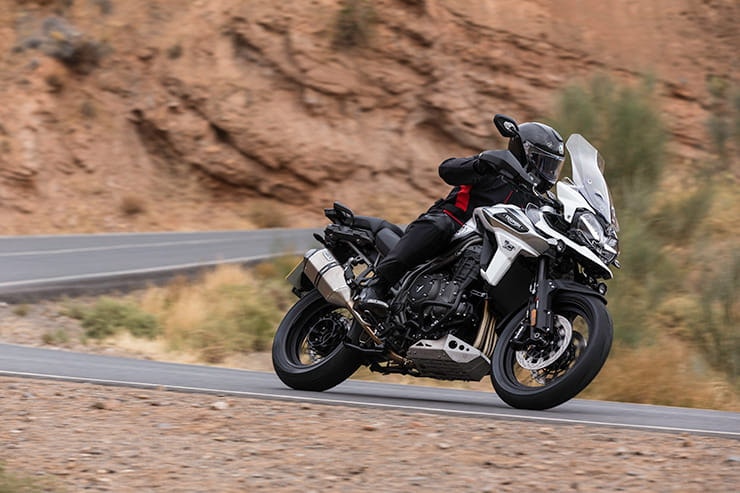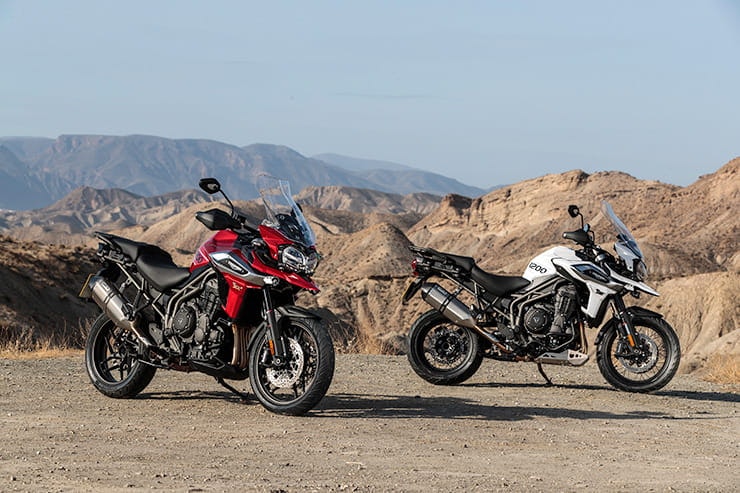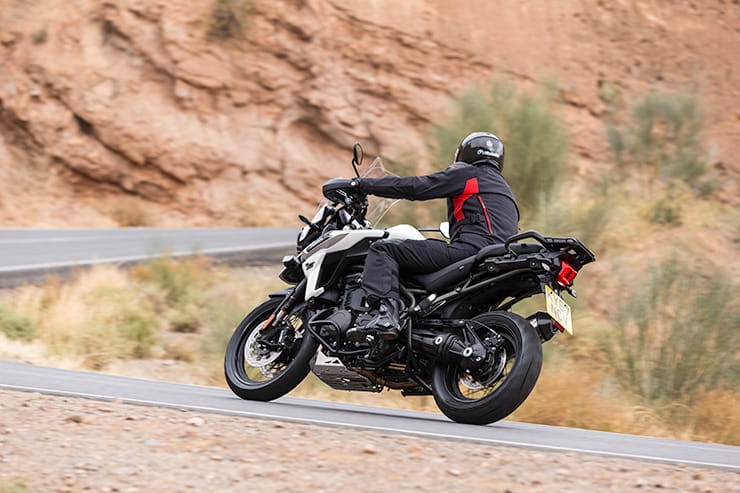Triumph Tiger 1200 XCA (2018) - Review
By Michael Mann
BikeSocial Managing Editor
30.11.2017
Kit Credits
Helmet
AGV Sport Modular, £549.95 | www.agv.co.uk
Jacket
Dainese D-Cyclone Gore-tex, £679.95 | www.dainese.com
Trousers
Dainese D-Cyclone Gore-tex, £429.95| www.dainese.com
Boots
Dainese D1 Out Gore-tex, £299.95 | www.dainese.com
Gloves
Dainese Universe Gore-tex, £189.95 | www.dainese.com
How neat are the Tiger’s new feet?
Of all the animals, I reckon the Tiger is among the most commercialised. People have sung about their eyes, feet or roar, used them to sell breakfast cereal or named themselves after the big, stripy cat when they’re rather good at hitting a small white ball over 300 yards.
Thankfully before songwriters, advertisers and sportsmen sunk their money-making teeth into the growly and large-pawed feline, Triumph hijacked the name and for the three motorcycles produced 80 years ago: 250cc Tiger 70, a 350cc Tiger 80 and a 500cc Tiger 90 were born to the British manufacturer in 1937 and while production ceased once WWII broke out and the Coventry production plant was destroyed, the name lives on.
Since then the Tiger has had more than just a handful of guises and was accompanied by the ‘Explorer’ moniker for the most recent and flagship adventure bike, that was until the new-for-2018 model was announced just a handful of weeks ago.
Triumph has significantly updated the Tiger 1200 range making it lighter, faster and a hell-of-a-lot more rider friendly with a plethora of electronical goodness dripping from every corner. But how did we get on when we rode the new bike at the press launch in Spain earlier this week? How does it compare to the old Explorer, what are its rivals and could it be one of the most advanced British bikes ever?
Triumph Tiger 1200 XCA (2018) - first impressions | BikeSocial
BikeSocial's Web Editor and Road Tester, Michael Mann, went to Almeria in Spain to ride the new-for-2018 Tiger 1200, both on and off road.
Let’s cut to the chase. With so many upgrades, there comes a price. A higher price than the outgoing model, obviously. The six-model bike range can be split in two by the more road-focused four XR models, distinguishable by their cast wheels, and the two XC models and their spoke wheels more suited to the dirt. They’ll all be in dealerships from mid-January 2018 with prices from £12,200 for the base spec XR rising to £16,950 for the top spec and fully pimped XCA – £1,000 more than the its predecessor. Yep, seventeen grand. You can get an awful lot of motorbike for 17-large but then again a PCP deal will make the Triumph an attractive option when considering how laden with tech it is. And not any old tech, either. User-friendly and intuitive making the riding experience blumming good.
The 1215cc motor with its customary three-cylinders and accompanying beautiful howl is improved, losing a bit of weight yet gaining 2bhp taking it up to 139bhp at its peak of 9350rpm, while Triumph claims even greater improvements to low-end thrust. A new, lighter silencer helps cut the whole bike’s mass as well as freeing up some more performance.
Once again, tech updates are much of the focus for 2018. All models but the base XR have TFT instruments with changeable themes and styles all controlled by the new 5-way joystick on the left bar, backlit bar controls, keyless ignition and full LED lighting. The top-end XRT and XCA gain a quick-shifter, working on both upshifts and downshifts, and adaptive cornering lights. The more off-road focussed XCA also has a sixth rider mode – Off Road Pro.
All models have got slight revisions to the riding position, and Triumph is claiming weight losses across the range. The base model and XRx are 2kg lighter, the XCx is 5kg less than the old model, the XCA loses 10kg and the XRT touring version is a full 11kg less than its predecessor. The weight is saved by a lighter flywheel, cam cover, crankshaft, silencer, engine bars, battery and sump guard.
On the Road
Having been briefed by around-the-world riding adventurer, celebrity chef and Triumph ambassador, Charley Boorman, on what each of the many buttons operate, he donned his shades and I lowered my flip-front AGV and off we headed for the Spanish mountains north of Almeria for a 190-mile road route sandwiching 25-miles of friendly off-roading. The guide riders had already been waxing lyrical about the quality of the roads, route and scenery.
To begin with I admit to feeling a little overwhelmed by the array of rider options from personalising each mode and determining the optimal height of the electronically adjustable screen to selecting how firm I wished the suspension and deliberating over how warm I fancied my seat. Thankfully, to lessen the chance of not concentrating on riding a new bike on unfamiliar roads, the home button on the right-side of the handlebars isn’t accessible on the move. However, on the left-side buttons to toggle rider modes, cruise control, heated seat, heated grips, and daytime running lights among others, are joined by indicators and horn plus the 5-way joystick controlling the new and glitzy TFT screen (new for the Tiger, anyway. It can be found on the Street Triple RS too) and all its information including theme, style, contrast, trip details. It’s a very user friendly system to see and scroll through the options but also operationally unless you’ve equipped your fingers with the fattest, warmest gloves. In which case I suspect a few miss-indications will slip in.
The Tiger 1200 is a strapping machine yet surprisingly easy to manoeuvre. Even with a dry weight of 248kg, Triumph have done a sterling job at distributing it, keeping the chassis balanced enough for some unexpectedly good handling along the fast, smooth and pretty exhilarating mountain roads. Flickable and comfortable with its rather sumptuous saddle and a riding position that has both plenty of leg room for a 6-footer like me thanks to the 855mm seat height (adjustable down to 835mm) and a set of handlebars 20mm nearer to me than the outgoing ‘Explorer’ model. The Tiger is a dextrous beast aided by a set of Metzeler Tourance Next tyres – 19” front and 17” rear – and, on the faster sections of the ride, the sport mode which is just a couple of joystick taps away. The semi-active, electronically adjustable suspension can be adjusted to an even more sporty setting should you require. I did but what was noticeable through the modes was how stable the bike was while changing gear – I deliberately tried to upset it by changing both up and down mid-corner.
The new ‘Triumph Shift Assist’ system allows for clutchless gear changing both up and down and while the action of selecting the gear needed to be firm, the bike barely altered its course and pitch by a millimetre when the new gear engaged. Same for the brakes; two 305mm discs with Brembo 4-piston callipers coped commendably with the weight of bike and rider plus speed of corner attack.
In the turns, Cornering ABS and Cornering Traction Control keep everything safe while the smooth impact of the ride-by-wire throttle gives the 139bhp (at 9,350rpm) and its accompanying urgency plenty of opportunity to march the rider on. The power curve is more like a power diagonal line until around the 8,000rpm mark as the brake-horses gallop away without hassle, jolts or sudden jerks. The silky delivery of power is joined by the familiar audible warmth of a triple but this time from the Arrow exhaust, attached the top spec models, enhancing the tone.
Between 5-7,000rpm comes a tidy power band increasing from 85-120bhp and that for me is the sweet spot of the 1215cc engine, offering a graceful surge before a quick flick with the left boot and into another gear. It’s very charming, satisfying and comforting without being too punchy and obnoxious, like a long-time garaged 2-stroke starting on the first kick instead of the ferocious and ankle-threatening pumping you were expecting.
Yes, it makes more power than a GS and is probably the more enjoyable to ride, quickly. It’s marginally heavier than the top spec Adventure BMW but that becomes insignificant when you consider the German carries 10kg (or 50%) more fuel than the Tiger. And therein lies a problem because an adventure-tourer, or however you’d like to categorise the Triumph, should be able to catapult you along the road for more than 200 miles before re-juicing. The annoyance of your BMW, Ducati or KTM-mounted chums might be appeased a little with extra time for Mars Bars or wee stops. Let’s face it, 200 miles in one sitting can be more than enough for some and, unless you frequent autobahns regularly, that’ll equate to around 3-hours in the saddle.
When quizzed about the 20-litre tank size, Triumph simply say that a bigger tank means more weight and that’s not on the cards.
Hill hold is a neat gadget. When stopped on an incline or decline, a quick squeeze of the front brake lever will actually engage the rear brake to stop you rolling until you introduce a little power and away you go. The rear view mirrors are easy to adjust, vibe-free (until 70mph) and large enough to detect Mr Boorman bunny hoping the speed humps 20 yards behind. Keyless ignition is one of those recently more common introductions that doesn’t bother me much – it becomes a faff when you arrive at the petrol station and forget which pocket you’ve put it in…if you’ve remembered the key at all. On the Triumph there is an electronically operated steering lock too.
Thankfully I got to cover a dozen miles or so as the night drew in which offered a chance to test the illuminated switchgear – a brilliant and simply invention to make it clear which of the 17 options of buttons I needed to press on the handlebar. I also could see how the new Adaptive Cornering Lights worked, where four additional LED lights sequentially illuminate depending on lean angle from the first at 3 degrees to the fourth at 31 degrees. Did they work? Yes. Did they make much difference? Not really but I’d reserve judgement until I get to test them on an unlit B-road at night.
The Tiger 1200 will be bought by many who in tend on carrying both pillions and luggage. Triumph offer an Expedition Pack with panniers, a top box, back rest pad and tank pad among its 50 other accessories while the higher, separated pillion seat is not only wide and moulded to fit snugly under each of your passengers’ legs but it’s also heated.
A taller ‘Touring’ screen is fitted to the XRT and XCA models as standard and is electronically operated, with ease, via the good old joystick though even in its highest setting which brings it to eye level it’s still doesn’t deflect as much wind as I’d hoped.
A press launch is never going to offer sensible or accurate economy so while Triumph claim 54.3mpg, I achieved probably the lowest result you’ll ever witness of 41.8mpg.
Off the Road
Pirelli Scorpion Rally tyres were fitted to the XCA’s primed for the off-road section of the press launch which used mainly flat, loose firetracks with the occasional hump or deeper sand/gravel section. A quick flick of the mode button to find either ‘Off Road’ or the new ‘Off Road Pro’ option before allowing the bike a few seconds to adjust itself and you’re good to go. Off Road Pro removes ABS and traction control leaving the rider/throttle connection to decide how much spin the rear was awarded.
I preferred the more secure feeling of ‘Off Road’ which acted like a safety blanket - it looks after you as the throttle blip spins the rear out when combined with a little steering input with the movement of weight on the pegs. But doesn’t allow the rear wheel to spin enough to lose control, so you feel like a rock star despite only being able to strum a couple of chords.
The Tiger stayed sturdy swallowing up the lumps and bumps, was a proper giggle to ride on the dusty, gravely tracks and using the quickshifter helped while standing on the pegs to flick seamlessly between the first three gears.
Colour options
XR: Jet Black or Crystal White
XRX: Jet Black, Crystal White or Matt Cobalt Blue
XCX: Jet Black, Crystal White or Matt Khaki
XRT: Crystal White or Korosi Red
XCA: Crystal White or Marine
The Triumph Adventure Centre
Why not try it off-road yourself? 4-time Dakar competitor, Nick Plumb, will be running the new Triumph Adventure Centre in the Spring. Based on the southern edge of the Brecon Beacons in Wales, the centre will provide training and forest routes using around 1,300 acres of ‘bespoke to Triumph’ Welsh playground.
Not only will the new Tiger 1200 be used but also the new Tiger 800 and Bonneville Scrambler.
VERDICT
The Tiger’s feet are neat. Courtesy of some serious investment and R&D by the Hinckley mob, the Tiger 1200 is a thoroughbred when it comes to rideability and enjoyment. Obvious comparisons to other adventure bikes don’t necessarily work in its favour if the rivalry boiled down simply to weight, fuel tank range and price but being realistic about what Triumph have produced, here is a highly commendable and competent touring bike with a set of adventure clothes on. Like Superman when he needs to burst into action, he’s always got his lycra on just in case. As I mentioned, the majority of owners won’t ever take it off-road but can be safe in the knowledge that it is equipped to do so just like the GS on which this entire sector can be thankful for.
An array of easy-to-use electronics and safety equipment add to the expressive and smooth engine; it’s a super package.
KEY RIVALS…or are they?
On paper, there’s an expectation the new Tiger 1200 would be ready to challenge the top spec, off-road, European super weapons but realistically for all the electronics and rider goodies the XCA has, as a touring bike let alone an adventure bike, it would come up short mainly through its aforementioned limited fuel tank.
Nevertheless, for those of you who fancy a quick comparison:
Looking ahead to 2018 and the Japanese brands are reinvigorating their own touring/adventure bikes in the shape of Yamaha’s Super Tenere and Honda’s even newer Africa Twin could be worthy of comparison. Add in the Honda VFR1200X, Suzuki V-Strom and Kawasaki Versys, among others, and competition really is fiercer than ever in this sector.
TECHNICAL SPECIFICATION
Share on social media:


